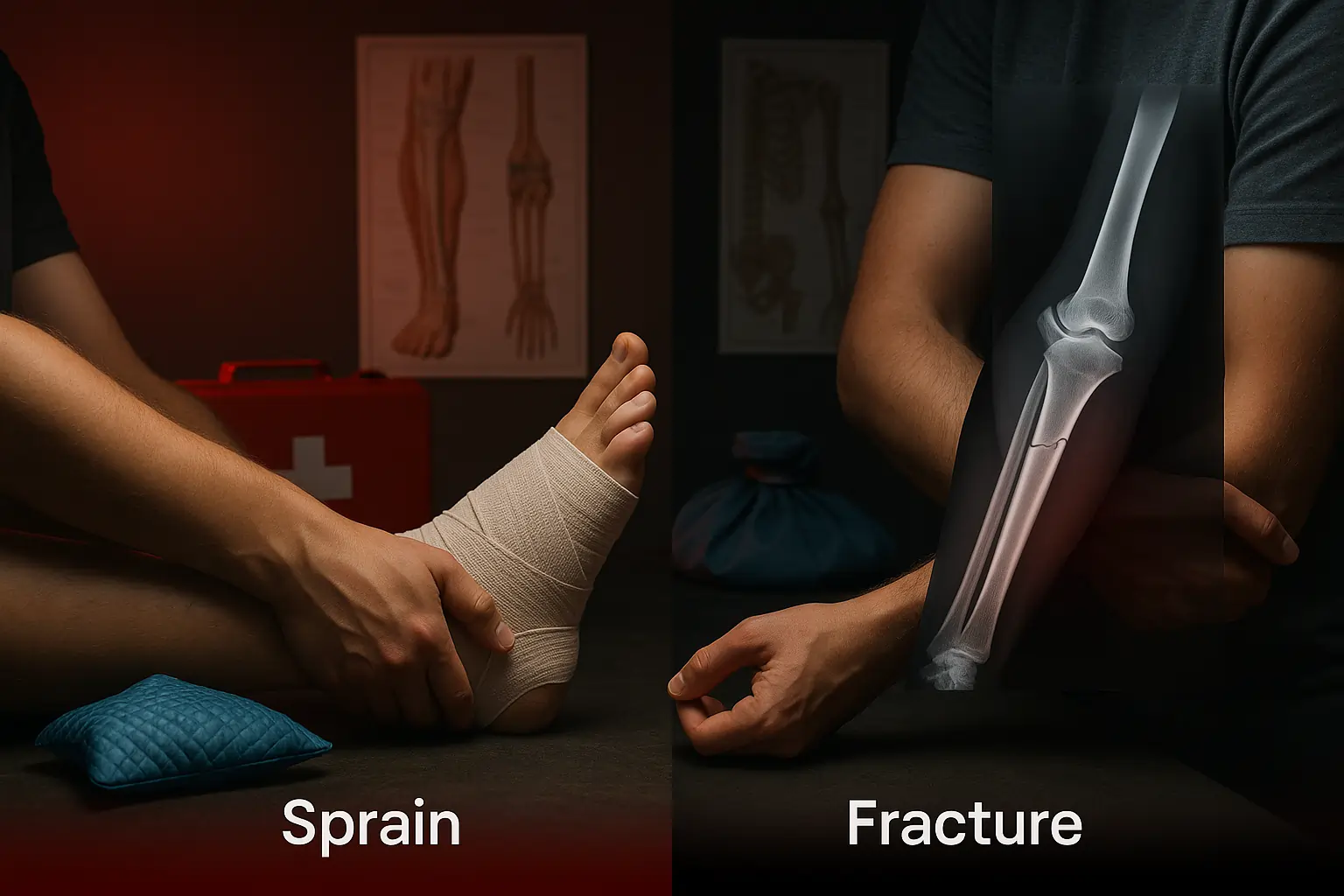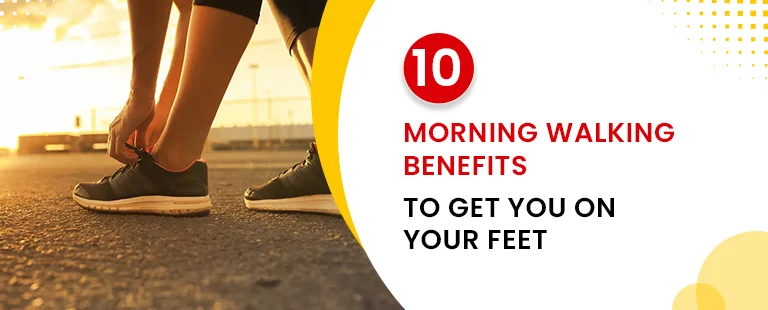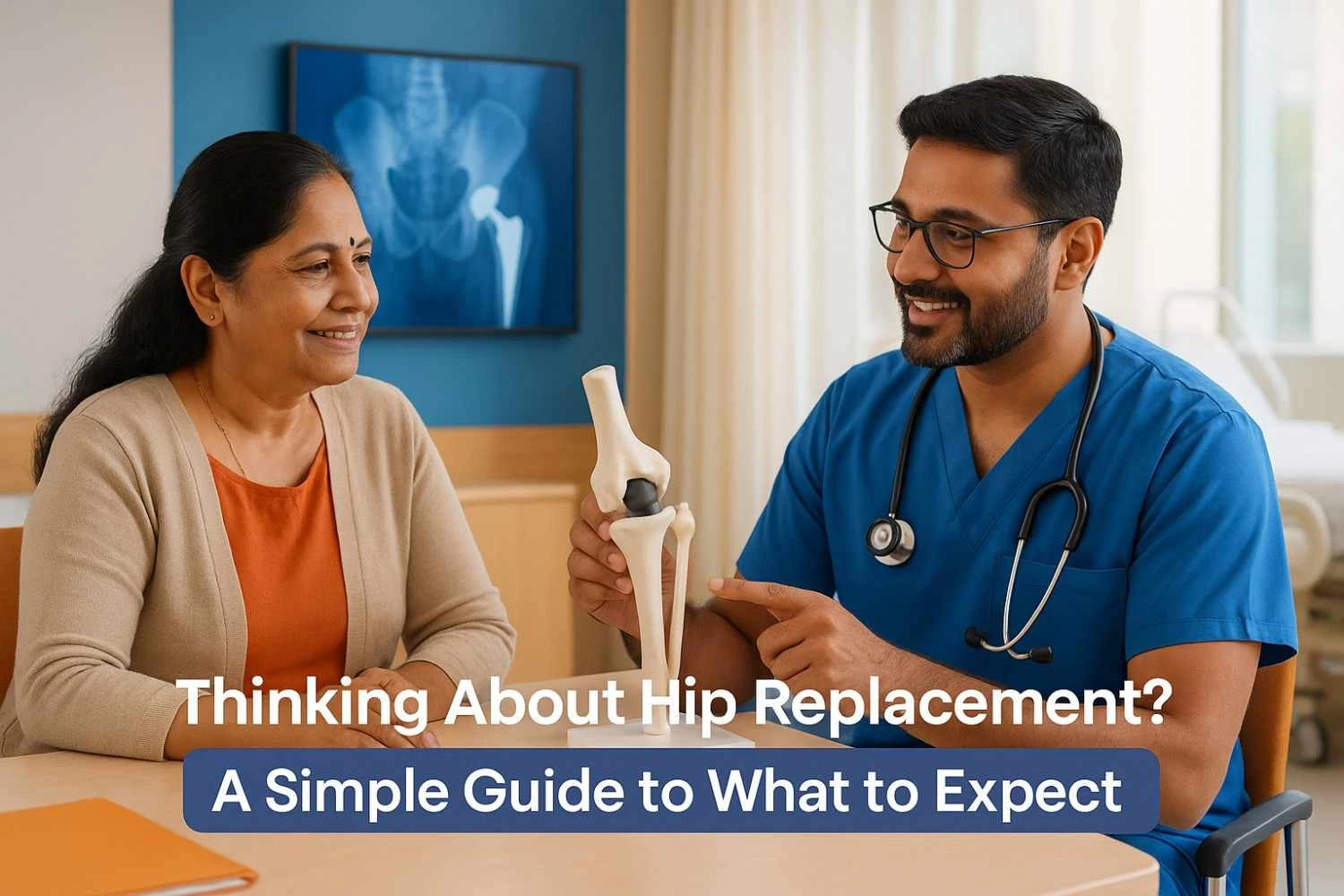It happens in a flash. A missed step on the stairs, an awkward landing during a game of cricket, or a simple slip on a wet floor. One moment you’re moving freely, and the next, you’re hit with a sudden, sharp pain in your ankle, wrist, or knee. In the middle of the shock and the throbbing ache, your mind races with one crucial question: “Is it just a sprain, or have I broken a bone?”
This uncertainty is common, and for a good reason. Both sprains and fractures are common injuries that can happen to anyone, and their initial symptoms, especially pain and swelling, can feel remarkably similar. However, understanding the key differences is vital. Treating a severe fracture like a minor sprain can delay proper healing and, in some cases, lead to long-term problems like chronic pain, joint instability, or even arthritis.
At Germanten Hospitals, India’s leading centre for orthopaedic excellence, we believe that knowledge is the first step to a fast and full recovery. This detailed guide is designed to give you the clarity you need in those critical moments after an injury. We will walk you through the fundamental differences between a sprain and a fracture, help you identify the distinct symptoms, explain the correct first aid for each, and highlight the clear warning signs that mean you should see an orthopaedic specialist immediately.
What is a Sprain? Understanding Ligament Injuries
To understand a sprain, you first need to know about ligaments. Think of them as the body's own heavy-duty elastic tapes.
The Role of Ligaments
Ligaments are incredibly tough, fibrous bands of tissue that connect one bone to another, holding your joints together. Their job is to provide stability and ensure your joints move correctly, but not excessively. They are the silent guardians that keep your ankles from rolling too far and your wrists from bending back unnaturally.
How a Sprain Happens
A sprain occurs when a joint is suddenly twisted or forced into an unnatural position. This sudden, forceful movement can stretch or even tear these ligament "tapes". This is why sprains are most common in highly mobile joints like the ankle, knee, and wrist. A simple trip on uneven pavement or a fall onto an outstretched hand is all it takes.
The Grades of a Sprain
Not all sprains are the same. Orthopaedic specialists classify them into three grades based on how severe the ligament damage is:
- Grade 1 (Mild): The ligament has been stretched but isn't torn. You’ll likely experience some mild pain and swelling, but the joint will still feel stable.
- Grade 2 (Moderate): This involves a partial tear of the ligament. The pain, swelling, and bruising will be more significant, and the joint might feel a bit loose or unstable.
- Grade 3 (Severe): This is a complete tear, or rupture, of the ligament. It causes intense pain, major swelling, and a feeling that the joint is completely unstable and cannot support you.
What is a Fracture? Understanding Broken Bones
While ligaments are flexible, bones are the rigid framework that gives our body its structure and protects our vital organs.
The Structure of Bones
Bones are strong, but they have their limits. In the medical world, the terms "fracture" and "broken bone" mean exactly the same thing. So, if a doctor tells you that you have a fracture, it means your bone is broken.
How a Fracture Occurs
A fracture happens when a force is applied to a bone that is stronger than the bone itself can handle, causing it to crack or break completely. This can happen from a major trauma like a car accident or a serious fall, but sometimes even repetitive stress, like from running, can cause tiny cracks in the bone.
Common Types of Fractures You Should Know
Fractures are more complex than just a simple break. Understanding the different types helps explain why professional medical care is so important.
- Closed (Simple) vs. Open (Compound) Fracture: This is the most critical difference for first aid. In a closed fracture, the bone is broken, but the skin is not. In an open or compound fracture, a piece of the broken bone has pierced through the skin, creating a wound and a serious risk of infection.
- Displaced vs. Non-displaced Fracture: In a non-displaced fracture, the bone cracks, but the broken pieces stay in their correct alignment. In a displaced fracture, the bone fragments have moved, creating a gap that will almost certainly need a doctor to put them back in place.
- Other Types: Specialists identify many other patterns. A comminuted fracture is when the bone shatters into three or more pieces. A greenstick fracture is an incomplete break often seen in children, whose bones are more flexible. A stress fracture is a tiny hairline crack caused by overuse.
Sprain vs. Fracture: How to Tell the Difference by Symptoms
In the moments after an injury, your body will give you clues. Paying close attention to these signs can help you make a better decision about what to do next.
The Sound of the Injury: A Pop or a Crack?
One of the biggest giveaways can be what you heard.
- Fracture: Many people report hearing a distinct and loud "crack" or "snapping" sound at the moment the bone breaks.
- Sprain: A sprain is often a silent injury. However, with a severe Grade 3 tear, you might feel or hear a "pop" as the ligament ruptures.
Pinpointing the Pain: Is it on the Bone or Around the Joint?
Try to identify exactly where the pain is coming from.
- Fracture: The pain is usually sharp, intense, and located directly over a bone. If you gently press on the bone itself and feel a sharp, specific point of pain, a fracture is very likely.
- Sprain: The pain is often more of a dull, throbbing ache that feels like it's in the soft tissue around the joint, rather than directly on the bone.
The Weight-Bearing Test: Can You Stand on It?
This is a simple functional test, especially for a leg or ankle injury.
- Fracture: It is typically impossible to put any weight on a limb with a broken bone. The pain is too severe, and the structural support is gone.
- Sprain: While it will be painful, you can often still bear some weight on a sprained limb. You might be able to limp, which is usually not possible with a fracture.
Visual Clues: Swelling vs. Deformity
Look closely at the injured area.
- Both will cause swelling and bruising.
- Fracture: The key sign of a fracture is a visible deformity. The limb might look bent at an odd angle, crooked, or clearly misshapen. This is a tell-tale sign that the bones are out of alignment.
- Sprain: You will see swelling and bruising, which can be quite dramatic, but the limb’s underlying shape will usually look normal.
Other Sensations: Numbness and Tingling
Pay attention to any other feelings besides pain.
- Fracture: A broken bone can sometimes press on or damage nearby nerves and blood vessels. This can cause feelings of numbness, tingling, or coldness in your toes or fingers. Some people also report a "grating" or "crunching" feeling if the limb moves, which is caused by the broken bone ends rubbing together.
- Sprain: A sprain usually just causes pain and a feeling of weakness or instability in the joint.
At-a-Glance Comparison Table: Sprain vs. Fracture
| Feature | Sprain (Ligament Injury) | Fracture (Bone Injury) |
|---|---|---|
| Sound at Injury | Usually silent; a "pop" may be felt in severe cases. | Often a distinct "crack" or "snap" is heard. |
| Pain Location | General, aching pain in the soft tissue around a joint. | Sharp, specific pain directly over the bone. |
| Ability to Bear Weight | Often difficult but may be possible (limping). | Typically impossible to bear any weight. |
| Visual Appearance | Swelling and bruising are the main signs; the limb shape is normal. | Obvious deformity or an unnatural angle is a key sign. |
| Other Sensations | Primarily pain and instability. | Pain often comes with numbness, tingling, or a grating feeling. |
Immediate First Aid: What to Do in the First Hour
What you do right after an injury can make a big difference in your recovery. The first aid for a sprain focuses on reducing swelling, while the first aid for a fracture is all about preventing any further damage.
First Aid for a Suspected Sprain: The PEACE & LOVE Principle (An Update to R.I.C.E.)
For many years, doctors recommended the R.I.C.E. method for sprains, and it is still a very helpful starting point.
- Rest: Stop your activity and avoid putting weight on the injured joint for the first 24-48 hours.
- Ice: Apply an ice pack (wrapped in a thin towel to protect your skin) for 15-20 minutes every 2-3 hours. This helps reduce pain and swelling. Never apply ice for more than 20 minutes at a time.
- Compression: Gently wrap the area with an elastic bandage. It should be snug, but not so tight that it causes numbness or more pain.
- Elevation: Keep the injured limb raised above the level of your heart whenever possible, especially when sitting or lying down. This uses gravity to help drain fluid and reduce swelling.
Most experts now agree that a more modern approach, known as the PEACE & LOVE principle, is even better for long-term healing. PEACE guides the first few days (Protection, Elevation, Avoid Anti-inflammatories, Compression, Education), and LOVE guides the later stages (Load, Optimism, Vascularisation, Exercise). This new approach emphasizes gentle movement after the initial rest period to promote better healing.
Also, remember to AVOID H.A.R.M. in the first 72 hours: Heat, Alcohol, Running, and Massage, as these can all increase swelling.
First Aid for a Suspected Fracture: Immobilisation is Key
If you have any reason to suspect a fracture, you must be much more cautious. The golden rule is: If in doubt, treat it as a fracture. The number one priority is to keep the injured area perfectly still to prevent the broken bone from moving and causing more damage.
- DO NOT MOVE the person unless they are in immediate danger (like in the middle of a road).
- IMMOBILIZE THE INJURY: Do not try to straighten the limb or push a bone that is sticking out back into the skin. This can cause severe damage to nerves and blood vessels and must only be done by a medical professional. If you are trained, you can apply a temporary splint to support the area above and below the break.
- CONTROL BLEEDING (for an open fracture): If the bone has broken the skin, use a clean cloth to apply firm pressure around the edges of the wound. Do not press directly on the exposed bone.
- APPLY A COLD PACK: Gently place an ice pack wrapped in a towel over the injury to help with pain and swelling, but do not move the limb to do so.
- TREAT FOR SHOCK: If the person feels faint, becomes pale, or is breathing rapidly, have them lie down with their head slightly lower than their body and elevate their legs if possible.
Why Self-Diagnosis Isn't Enough: The Role of an Orthopedic Specialist
While these tips can help you assess the situation, they are not a substitute for a professional medical diagnosis. The symptoms can overlap, and only a trained specialist can determine the true extent of your injury.
The Dangers of 'Waiting It Out'
Many people with a painful ankle or wrist might think, "It's just a sprain, I'll rest it for a few days." This can be a dangerous mistake. According to a 2025 report from sports medicine specialists, delaying treatment for a serious injury can lead to worse long-term outcomes, including chronic joint instability that may eventually require more complex surgery. What might have been a straightforward fix can become a long-term problem.
How Doctors at Germanten Hospitals Diagnose Your Injury
At Germanten Hospitals, our orthopaedic experts use a systematic process to get a precise diagnosis, leveraging both their clinical experience and Germany’s world-class medical technology.
- Physical Examination: The process starts with a conversation. Your doctor will ask exactly how the injury happened, as the mechanism often provides important clues. They will then conduct a careful physical exam, gently feeling the area to find the exact point of tenderness and assessing your range of motion.
- Advanced Imaging: To see what’s happening inside, imaging tests are essential. An X-ray is the fastest and best way to confirm or rule out a fracture. If the X-ray is clear but your symptoms are severe, your doctor may order an MRI, which gives a highly detailed view of soft tissues like ligaments, to check for a serious tear.
Treatment Pathways: From Simple Rest to Advanced Surgery
Once we have an accurate diagnosis, our team at Germanten will create a personalised treatment plan to get you back on your feet.
Treating Sprains: Restoring Joint Stability
The goal is to help the ligament heal properly and strengthen the joint to prevent future injuries.
- Mild to Moderate Sprains: These are usually treated with the R.I.C.E. method, sometimes with a brace for support.
- Physical Therapy: This is a crucial part of recovery for most sprains. Our expert physiotherapists will guide you through exercises to restore strength, flexibility, and balance, which is vital for preventing the injury from happening again.
- Surgery: Surgery for a sprain is rare but may be needed for a complete ligament rupture in a young, active person or a professional athlete to restore full stability to the joint.
Treating Fractures: The Goal of Perfect Alignment
For a bone to heal correctly, the broken pieces must be perfectly aligned and held still.
- Non-Surgical Treatment: If the bone is not badly displaced, a doctor may be able to manually realign it in a procedure called a reduction. The limb is then immobilised in a cast or a splint to hold the bones in the correct position while they heal.
- Surgical Treatment: For more complex or unstable fractures, surgery is often the best option. At Germanten, our surgeons are experts in Open Reduction and Internal Fixation (ORIF), a procedure where they surgically realign the bone and use specialised plates, screws, or rods to hold the pieces together internally. This provides excellent stability and often allows for a quicker return to movement.
Red Flags: When to Go to the Emergency Room Immediately
Some injuries are medical emergencies. Do not wait. Go to the nearest emergency department or an orthopaedic urgent care facility if you experience any of the following:
- Obvious Deformity: The limb is clearly bent, crooked, or looks misshapen.
- Bone Protruding Through the Skin: This is an open fracture and requires immediate attention to prevent infection.
- An Audible "Crack" or "Snap" accompanied by severe, immediate pain.
- Complete Inability to Bear Weight on your leg, ankle, or foot.
- Loss of Sensation or Circulation: The area feels numb, you have significant tingling, or your hand or foot turns cold, pale, or blueish. This could signal nerve or blood vessel damage.
- Severe, Uncontrolled Pain or Swelling that doesn't get better with first aid.
- Any Suspected Injury to the Head, Neck, or Back. Do not move the person and call for an ambulance immediately.
Your Recovery Journey with Germanten Hospitals
The path from a painful injury to a full recovery starts with making the right choices. By understanding the signs of a sprain versus a fracture, applying the correct first aid, and knowing when to seek help, you are already taking control of your health.
However, the most important decision is to not leave your recovery to chance. A definitive diagnosis from an orthopaedic specialist is the only way to ensure you get the right treatment. At Germanten Hospitals, our team of German-guided doctors and Indian orthopaedic experts combines decades of experience with the latest in diagnostic and surgical technology to provide you with world-class care. From an accurate diagnosis to a personalised treatment and rehabilitation plan, we are with you every step of the way.
Don't guess with your health. If you've suffered an injury, book an appointment with our orthopaedic experts today and take the first confident step towards a full and lasting recovery.




